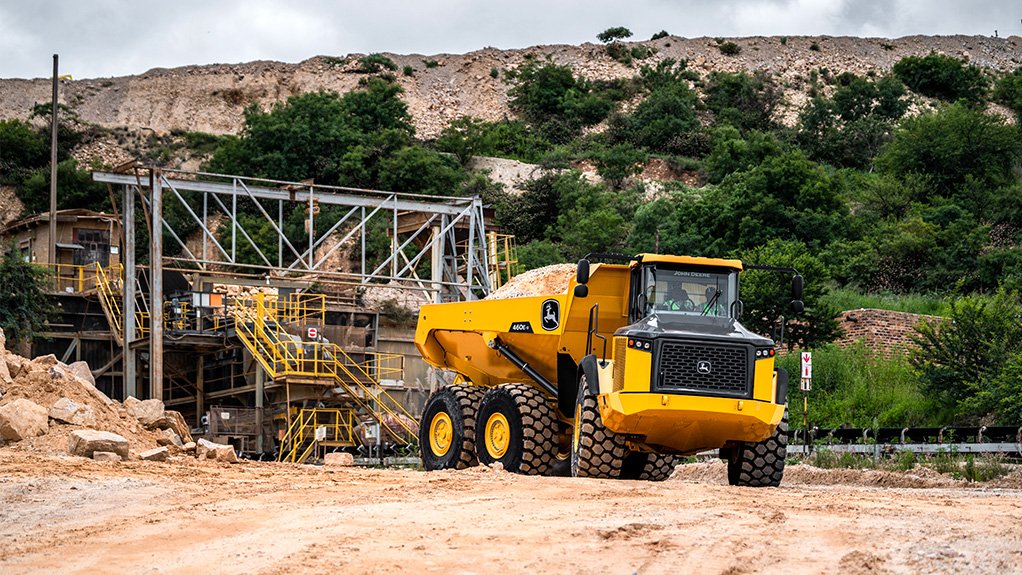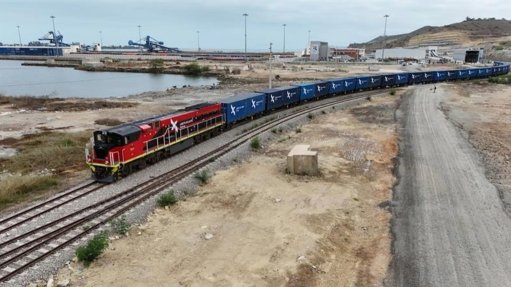Equipment giant to deliver 1.5-million low-carbon vehicles by 2026


DOING THE HEAVY LIFTING John Deere South Africa's newly released articulated dump truck, which can be used for African mining applications
US-headquartered equipment manufacturer John Deere promises to deliver 1.5-million low or no carbon machines by 2026 to dealers across its 54-country network, including the company’s South African headquarters in Boksburg, Gauteng.
John Deere construction and forestry sales manager for Southern Africa Griffiths Makgate says the company is gearing up to introduce hybrid vehicles, which will be followed by electric heavy equipment, including an excavator, in the near future.
John Deere is looking to expand its reach into the African mining equipment market, with servicing in Southern Africa out of its Boksburg-based headquarters.
He notes that there are a few considerations one would need to make prior to purchasing an electric item of heavy equipment, as these powerful machines are more expensive than their conventionally-powered predecessors, owing to their electronic features and function.
However, the maintenance of an electric piece of heavy equipment is cheaper over the long-term as there are less operational expenses.
“The customer must think about the means of support with these machines, as a customer can’t fix it themself. They must consider suitable people who are more clued up, meaning having to always go back to the original-equipment manufacturer (OEM),” says Makgate.
He cautions those who may have ambitions to go fully electric, explaining that, based on the duration cycles and durability of the machines, the vehicle can easily fail at a certain point where its owner may find themselves needing to acquire a certain component. This may lead to an operator spending as much as a third, if not 50% of the same amount that they paid to purchase the machinery, to replace the batteries and other parts.
Nonetheless, Makgate notes that hybrid machines have a better balance of efficiencies in comparison to electric machines.
With electric vehicles, the only major mechanical consideration is to ensure the machine has sufficient oil levels.
“Your downtime will be less, but the cost implications on a fully-fledged electronic machine are higher,” he notes.
Makgate also points out the charging of an electric piece of heavy equipment may become problematic.
However, he says hybrid equipment can be charged by the operator or through using the onboard engine.
Makgate notes that, depending on the duration of shifts, the operative longevity of electric machines can be up to eight hours before a recharge is required.
Depending on the kind of operation, it can take a minimum of 30 minutes recharge time for the hybrid machine to charge.
“For as long as a hybrid machine runs, it self-charges and produces power, which is stored. While running, it transfers that power to the wheels directly and when the battery power drops to a certain level, the engine also charges the battery,” he explains.
Makgate highlights that hyper hybrid vehicles have been in other markets such as the US since 2013, pointing out, however, that it will be a long time before these machines come to South Africa, owing to a variety of reasons.
He explains that the engine emission rating for these vehicles is not intended for Africa, as it is a European and US specified Tier 4 engine, which is based on tighter engine tolerances, and requires cleaner fuel than is available in Africa where only up to Tier 2 engines can be operated.
Nonetheless, Makgate adds that the technology installed in John Deere mining vehicles guarantees energy efficiency, stating that the transmission ratios on the company’s articulated dump trucks (ADTs) ensure that the engine is not misused between gears when driven.
“We have different phases like eco mode and power mode which utilise the right amount of fuel for the right application. Depending on the conditions of the work load, the machine will select the applicable mode for the operation,” he says.
In addition to the vehicle fuel efficiency, John Deere dump trucks are fitted with air cooled axle which cool down the axle as the vehicle runs, while graders have a function that filters the oil, something that is not present on some machines.
He adds that an auto-reversible radiator fan option allows for cooling and can also be adjusted and set automatically to operate in reverse to clear dust and debris out of the radiator every thirty minutes for five seconds by blowing air out.
Makgate says John Deere has been doing well since starting out by selling utility products to the mining industry, such as small wheel graders, backhoe loaders, excavators and skid steers, before introducing and selling production-class machines, such as bulldozers, motor graders, excavators and ADTs, to the market.
John Deere also intends to expand its mining offering, which currently primarily comprises ADTs and dozers, soon.
Article Enquiry
Email Article
Save Article
Feedback
To advertise email advertising@creamermedia.co.za or click here
Comments
Press Office
Announcements
What's On
Subscribe to improve your user experience...
Option 1 (equivalent of R125 a month):
Receive a weekly copy of Creamer Media's Engineering News & Mining Weekly magazine
(print copy for those in South Africa and e-magazine for those outside of South Africa)
Receive daily email newsletters
Access to full search results
Access archive of magazine back copies
Access to Projects in Progress
Access to ONE Research Report of your choice in PDF format
Option 2 (equivalent of R375 a month):
All benefits from Option 1
PLUS
Access to Creamer Media's Research Channel Africa for ALL Research Reports, in PDF format, on various industrial and mining sectors
including Electricity; Water; Energy Transition; Hydrogen; Roads, Rail and Ports; Coal; Gold; Platinum; Battery Metals; etc.
Already a subscriber?
Forgotten your password?
Receive weekly copy of Creamer Media's Engineering News & Mining Weekly magazine (print copy for those in South Africa and e-magazine for those outside of South Africa)
➕
Recieve daily email newsletters
➕
Access to full search results
➕
Access archive of magazine back copies
➕
Access to Projects in Progress
➕
Access to ONE Research Report of your choice in PDF format
RESEARCH CHANNEL AFRICA
R4500 (equivalent of R375 a month)
SUBSCRIBEAll benefits from Option 1
➕
Access to Creamer Media's Research Channel Africa for ALL Research Reports on various industrial and mining sectors, in PDF format, including on:
Electricity
➕
Water
➕
Energy Transition
➕
Hydrogen
➕
Roads, Rail and Ports
➕
Coal
➕
Gold
➕
Platinum
➕
Battery Metals
➕
etc.
Receive all benefits from Option 1 or Option 2 delivered to numerous people at your company
➕
Multiple User names and Passwords for simultaneous log-ins
➕
Intranet integration access to all in your organisation

















